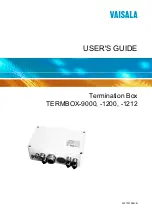
USER MANUAL
GWR Router Series
38
Remote Security
Gateway Type
Select the remote LAN user(s) behind the Router at the other end that can use this
IPSec tunnel. Select the type you want to use: IP or Subnet.
NOTE: The Remote Security Group Type you select should match the Local Security
Group Type selected on the IPSec device at the other end of the tunnel.
IP Address
Only the computer with a specific IP address will be able to access the tunnel.
Remote ID type
How the of the participant should be identified for authentication; Can be an IP
address, fully-qualified domain name (FQDN) or User FQDN name preceded by
@
Remote Security Group
Type
Select the remote LAN user(s) behind the Router at the other end that can use this
IPSec tunnel. Select the type you want to use: IP or Subnet.
NOTE: The Remote Security Group Type you select should match the Local Security
Group Type selected on the IPSec device at the other end of the tunnel.
IP Address
Only the computer with a specific IP address will be able to access the tunnel.
Subnet Mask
Enter the subnet mask.
Enable tunnel failover
Enable tunnel failover. If there is more than one tunnel defined, this option will
failover to other tunnel in case that selected one fails to established connection.
Ping IP
IP address on other side of tunnel which will be pinged in order to determine
current state.
Ping interval
Specify time period in seconds between two ping
Packet size
Specify packet size for ping message
Advanced Ping Interval
Time interval between advanced ping packets.
Advanced Ping Wait
For A Response
Advanced ping proofing timeout.
Maximum numbers of
failed packets
Set percentage of failed packets until failover action is performed.
Negotiation Mode
This option enables selection from three IPSec modes:
Main, Aggressive
and
Base
. If option NAT Traversal is selected Aggressive mode is predefined.
Compress (IP Payload
Compression Protocol
(IP Comp))
IP Payload Compression is a protocol that reduces the size of IP datagram. Select
this option if you want the Router to propose compression when it initiates a
connection.
Dead Peer Detection
(DPD)
When DPD is enabled, the Router will send periodic HELLO/ACK messages to
check the status of the IPSec tunnel (this feature can be used only when both peers
or IPSec devices of the IPSec tunnel use the DPD mechanism). Once a dead peer
has been detected, the Router will disconnect the tunnel so the connection can be
re-established. Specify the interval between HELLO/ACK messages (how often
you want the messages to be sent). The default interval is 20 seconds.
NAT Traversal
Both the IPSec initiator and responder must support the mechanism for detecting
the NAT router in the path and changing to a new port, as defined in RFC 3947.
NOTE: If you select this mode the Aggressive mode will be automatically selected because
it is obligatory option for NAT-T to work properly.
NOTE: Keep-alive for NAT-T function is enabled by default and cannot be disabled. The
default interval for keep-alive packets is 20 seconds.
Send initial contact
The initial-contact status message may be used when one side wishes to inform
the other that this is the first SA being established with the remote system. The
www.4Gon.co.uk [email protected] Tel: +44 (0)1245 808295 Fax: +44 (0)1245 808299
















































